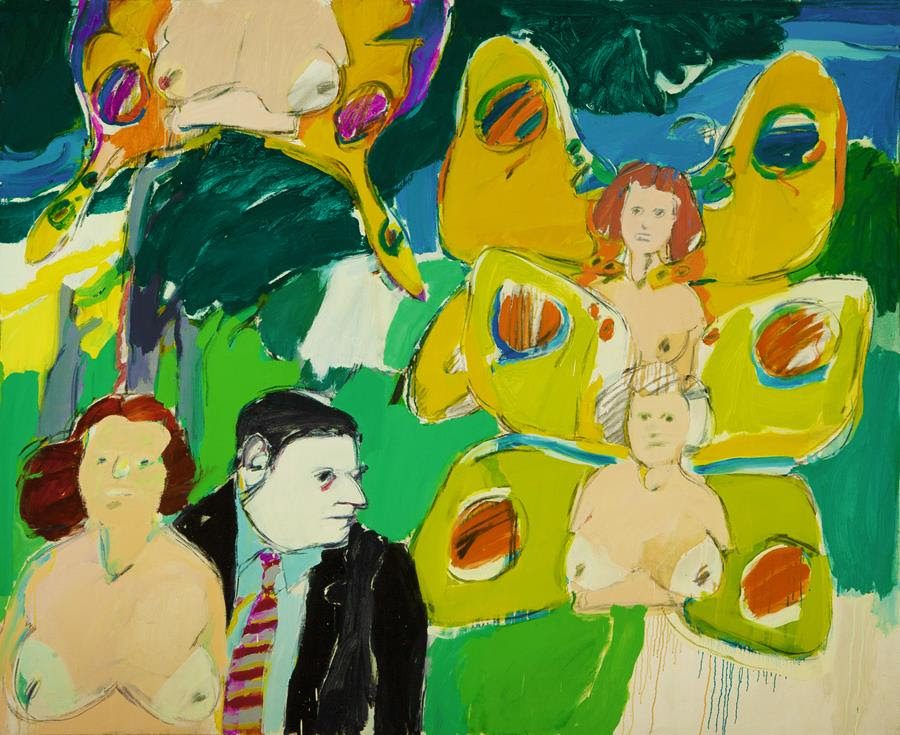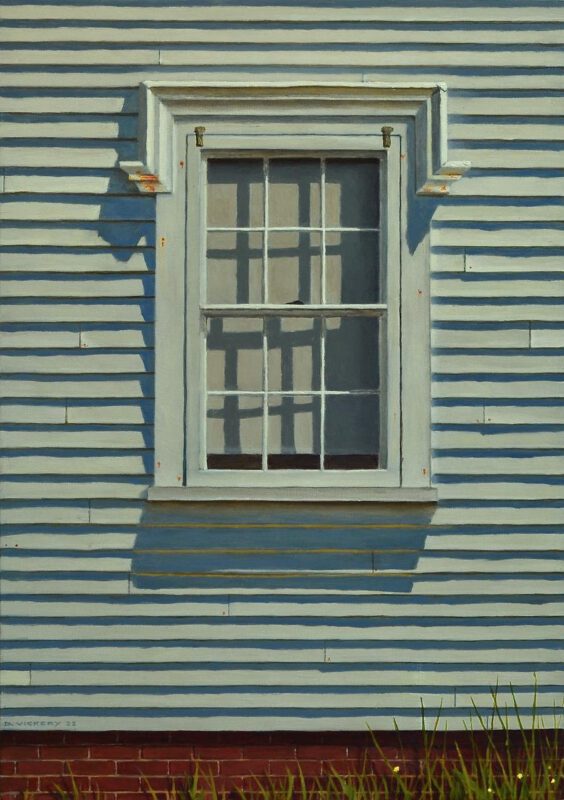
During May, Dowling Walsh Gallery will host three exhibitions. An opening reception will be held from 4 to 7 p.m. May 6 outside behind the gallery. Masks are encouraged while inside the gallery.
Dowling Walsh Gallery is at 365 Main St. in Rockland. The gallery is open from 10 a.m. to 5 p.m. Tuesday through Saturday and by appointment on Sundays and Mondays. Visit www.dowlingwalsh.com, or call 207-596-0084 for more information.
Neil Welliver (1929-2005)
“Chrysalis | 1954-1964”
May 6 to June 25
Neil Welliver was born in 1929 and raised in rural Millville, Pennsylvania, between two world wars and among forested hillsides and nearby streams. He received his initial art training at the Philadelphia Museum School of Art, with access to the museum’s encyclopedic collection of European and American art. There, he would have also encountered avant-garde works by Marcel Duchamp incorporating elements of accident and chance.
His first teaching job was with Cooper Union in New York where his own education continued and intensified through the emergence of Abstract Expressionism and the radical abstract paintings of Jackson Pollock, Franz Kline, Joan Mitchell, and especially Willem De Kooning. De Kooning’s paint slathered women — primal earth goddesses — confronted a startled public including young artists like Welliver.
After teaching at Cooper Union, Welliver joined the faculty at Yale under the venerable German expatriate, Josef Albers. Welliver seems to have rebelled against Albers’ highly structured geometric abstraction, most evident in his teacher’s ongoing “Homage to the Square” series. But he also absorbed lessons of color, light and discipline.
He remained at Yale until the mid-1960s, when he took a position with the University of Pennsylvania in Philadelphia, until retiring in 1989. Moving full-time to a large tract of land in Lincolnville, Maine, in 1970, the artist began to eliminate all traces of human presence. These wall-size landscapes are based on numerous smaller drawings and oil studies created en plein air, that he scaled up and rendered back in his barn-like studio.
Noted art critic Robert Hughes described these works as “among the strongest images in modern American art.” Welliver painted nearly every day, including winter excursions into the isolated, northern Maine woods — often with a 70-pound backpack full of paints and sketchpads — until his death in 2005.
Welliver’s little known and seldom exhibited early paintings in the current exhibition were mostly created during the 1950s through the early 1960s when he was studying and teaching at Cooper Union and Yale University. There is abundant, uncontrolled joy and humor in these raucous, good-natured paintings — a tuba player tooting her own horn. Tie-wearing fellow faculty and friends set in New Haven, enjoying their own get-togethers on loosely manicured, suburban lawns. Skeletons skinny-dipping in a sylvan pool — a comment on academic pastimes and purposes, we wonder? The color harmonies are not so much based on Albers’ color theories as having escaped from them. Paint handling is loose, celebrating accidental runs and drips, acknowledging how paintings are born. Indeed, the wild, uninhibited paintings in this rare look at the artist’s first exuberant body of work anticipates much that will define his later landscapes of the deep Maine woods. How boundless energy and natural processes are chaotic and essential. Welliver simply and persistently celebrates the act of painting; how paint — this colored mud — behaves on canvas.
The early paintings are Welliver’s manifesto of independence and escape — his artistic metamorphoses from student to teacher to artist. Abstraction and representation, nudes and skeletons, greet one another, gather in one place as fragile vehicles, unfurled butterfly wings traversing oceans, continents. And, to where poetry survives, according to W.H. Auden, “in the valley of its making.”

David Vickery
“Casting Shadows”
May 6 to 28
David Vickery is known for his precise realism and exploration of light and space. His subjects include both interiors and the landscape around him. His recent works focus on architectural elements, showing texture and repetition of pattern that reflect a passage of time.
Based in Cushing, Maine, he has been working from his studio there since 1991. His work has been exhibited at the Farnsworth Museum, Rockland; College of the Atlantic, Mount Desert; Sherry French Gallery, New York; and the Center for Maine Contemporary Art, Rockland.

“Plyos”
Tessa Greene O’Brien, Tollef Runquist, and Jamie Gray Williams
May 6 to 28
“Plyos” is a group exhibition of paintings by Tessa Greene O’Brien, Tollef Runquist and Jamie Gray Williams presented in tandem with Neil Welliver’s early figurative paintings. These artists utilize bold colors, gestural techniques and loose approaches to representing figures and spaces. The Greek roots of the word plyo refer to an increase, a pushing of limits, just as these painter’s test the limits of the canvas borders with implied action, layers of movement folding in on themselves. In these works color becomes a force and subject as important as the imagery. They capture the viewer, allowing us to fall into the work and be consumed.
Join award-winning painter Terri Brooks for “Figures in Pastels,” a workshop designed for experienced pastel artists. Working from a live, costumed model, participants will refine their ability to capture the human form using layered pastel techniques. The class will focus on essential life-drawing skills, using light and shadow to define facial structure and form through […]
The Deer Isle Artists Association announces the March Artist-in-Residence Program on March 4 with artist David McBeth. McBeth is a potter, working primarily with porcelain that is high-fired and ready for the dining table. Additionally, he is a knitter, whose preferred material is wool yarn. A true renaissance man, lately McBeth is also a writer, […]
Established in 2010, The Maine Museum of Photographic Arts is the only museum in Maine dedicated exclusively to photography. Dear Friends of the Maine Museum of Photographic Arts, What a transformative year 2024 has been for MMPA. As we reflect on the past twelve months, we’re struck by the extraordinary level of artistry, scholarship and […]
The Center for Maine Contemporary Art (CMCA) presents its winter season with the unveiling of two new thought-provoking exhibitions and held an opening reception on Feb. 1. New exhibitions that opened Feb. 1: “The Sun, Trying to Disappear” is a show that speaks of entanglement. The images in this exhibition flutter between icons and mistrusted […]
Crescendo is about reaching new heights, riding the waves of life, climbing peaks, looking up to the zenith, witnessing the culmination of a project, peering over the crest, feeling the surge of emotions. 2025 is a 9 year in numerology, marked by a crescendo of power and experience, acclimation and completion, and new beginnings. Artists […]
Joseph Fiore (1925-2008) was a widely respected artist and active member of the Maine Art Gallery during the 1960s and ‘70s. In celebration of the 100th year of his birth, the gallery is partnering with Maine Farmland Trust (MFT) on an exclusive and overdue major retrospective, “Fiore at 100: Maine Observed.” The show runs June […]
The Midcoast Downeast Chapter of the Union of Maine Visual Artists, in collaboration with Waterfall Arts and Dark Sky Maine presented “Dark Skies: Artwork Honoring Dark Nights in Maine,” which ran from Jan. 17 to Feb. 28 at Waterfall Arts in Belfast. Not only did the exhibit gather a sizable crowd of over 280 people […]
In March the Roux & Cyr International Fine Art Gallery will host its first abstract contemporary artist as its featured artist of the month. Jeanne Maguire, a Maine-based abstract artist, will be the First Friday artist on March 7. Maguire’s show is titled “Feminine Archetypes” and her work is vibrant and expressive, capturing the emotion […]
Youth Art Month is right around the corner. Show your support and celebrate the young artists in this year’s youth show, “Healing Through Color,” on view March 6 to 9. Students from all instructional levels will be featured in the show, which emphasizes the importance of visual arts, creative expression, and access to the arts […]
Receive news and information about Maine artists and events delivered right to your inbox.